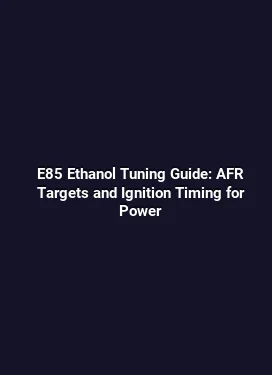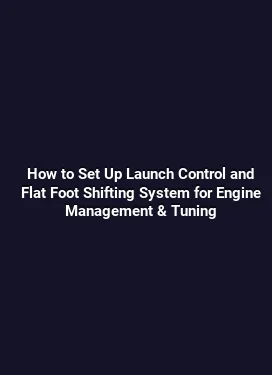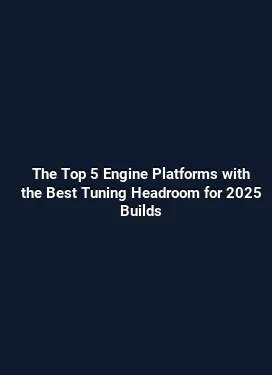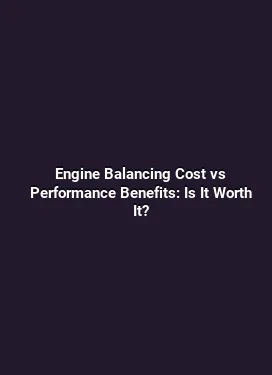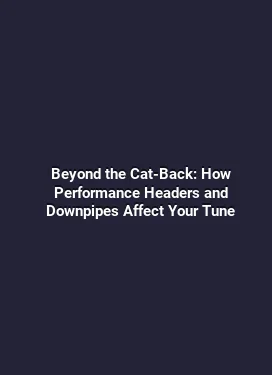Best Connecting Rods for 800HP Nissan RB25DET Engine Build
Understanding RB25DET and Power Targets

The RB25DET is a robust platform known for its broad torque curve and strong potential for high horsepower builds. When targeting 800 horsepower, the connecting rods become a critical element in the engine’s reliability and peak performance. The goal is to balance strength, weight, fatigue resistance, and compatibility with upgraded pistons, wrist pins, and bearings. This balance ensures the bottom end can sustain repeated high-load events, including sustained boost pressure, high rpm operation, and aggressive ignition timing strategies that are common in tuned RB25 builds.
Key considerations start with understanding the load path inside the block. The connecting rods must span the distance between crankshaft journal and piston pin, transmitting combustion forces while withstanding repeated bending and torsional stresses. In high-boost, high-rpm applications, rod selection also interacts with crankshaft quality, main bearing support, and oiling strategy. A well-matched rod set aligns with the engine’s overall tuning plan, fueling strategy, and boost management to minimize detonation risk and maximize power delivery across the rpm range.
Selecting Connecting Rods for High-HP RB25DET Builds
Choosing the right rods involves evaluating material composition, geometry, and manufacturing tolerances. Common options include forged steel, forged aluminum, and sometimes billet steel, each with distinct performance envelopes. For an 800hp RB25DET, a forged steel rod with a precise heat-treated finish is a frequent choice due to its superior fatigue strength, predictable behavior under heat soak, and compatibility with high-performance fasteners. Aluminum rods, while lighter, often pose higher bearing and fatigue risk in sustained high-boost environments and are typically reserved for lower-mileage race applications with strict maintenance intervals.
Rod length and weight are not merely about stiffness; they influence piston velocity, wrist pin loads, and the overall package dynamics. A longer rod with a favorable rod ratio can reduce piston accelerations at top dead center, smoothing high-rpm operation, yet it must be compatible with the crank diameter, cylinder bore clearance, and oiling system. Matching the rod’s big-end width and thickness to the crank cheek also minimizes bearing wear and harmonics that can translate into knocking or unusual backlash at elevated RPMs. In practice, many RB25 builders opt for rods in the 140–150 mm length range, balancing stroke, piston velocity, and availability from reputable manufacturers.
Materials, Heat Treatment, and Surface Finish

For reliability at 800 horsepower, forged steel rods with a controlled heat-treat process and surface hardening tend to deliver the best combination of strength and durability. The microstructure should resist fatigue under high cyclic loading, especially when boost levels push peak cylinder pressures well beyond stock values. Surface finishes, including shot peening and friction-optimized journal surfaces, contribute to bearing retention and consistent oil clearance under heat. A robust rod also features chamfered oil passages to reduce restriction and improve lubrication to the rod bearings, a factor that becomes critical during sustained high-rpm runs in tuned RB25s.
Manufacturers may offer different alloy variants, such as 4340 or 300M steel, each with specific fatigue limits. When considering the upgrade, it’s essential to confirm that the rod bolts or studs have been upgraded to a high-tensile grade compatible with the rod’s bolt holes. This prevents bolt failure under the loads generated by high-boost mappings and aggressive ignition timing strategies that promote high cylinder pressures at peak torque.
Rod Geometry, Weight, and Balance Considerations
Rod geometry directly affects piston acceleration, which in turn influences ring seal, oil control, and bearing wear. A well-chosen rod length and rotary inertia help maintain stable engine dynamics during throttle transitions and gear changes. In practice, balancing the rotating assembly with aftermarket rods requires careful attention to rod weight compatibility with the pistons, wrist pins, and bearings to achieve a harmonized balance factor across all rods. Imbalances can manifest as harmonics that stress the crank and bearings, especially in engines tuned for high power output where harmonic content shifts with rpm and boost pressure.
Weight distribution also matters for rod-to-crank journal engagement. Heavier rods increase inertia, which can demand stiffer valve timing strategies and potentially alter engine response during rapid throttle inputs. Conversely, lighter rods reduce inertial loads but may require more exacting manufacturing tolerances to maintain reliability under load. The practical takeaway is to select a rod set designed to work with the engine’s dynamic balance, crankshaft counterweights, and after-market rotating assembly components, ensuring consistent oiling and bearing life across the rev range.
Weight Matching and Piston-Rod Compatibility
When upgrading to high-horsepower components, it’s crucial to match rod weights with piston mass and wrist pin weight to maintain proper piston stability. An imbalance can cause increased piston slap, higher bearing loads, and accelerated wear. Builders typically measure rod weight in grams per rod, then pair them with pistons and pins that yield an overall rotating assembly with a balanced inertia profile. This harmony is particularly important in the RB25DET, where the stock short block has limited internal clearance and tight tolerances that can become amplified under boost and high rpm.
Fasteners, Bearings, and Oiling Strategy
Upgrading rod bolts or studs is almost mandatory in high-boost, high-power builds. High-strength fasteners with appropriate thread engagement and clamping force prevent rod cap movement under peak cylinder pressures. In addition, selecting compatible rod bearings with suitable thickness and hardness helps maintain oil film integrity at elevated temperatures. Oiling strategy should be revised to ensure adequate pressure and flow to the rod bearings, especially during gearing up for big boost events where oil demand rises. This often means upgrading oil pumps, pickup geometry, and in some scenarios, using a windage tray to reduce oil aeration and cavitation at high rpm.
It’s also prudent to verify that the rod bolts align with the bolt holes and cylinder wall clearance, preventing any interference with the piston skirts or ring pack during full-throttle operation. A reliable RB25DET build balances the rod assembly with crank and main bearings to preserve consistency in oil clearance and bearing temperatures across testing sessions and real-world driving scenarios.
Practical Installation Considerations and Common Pitfalls
During installation, ensuring proper torque procedures and angle-tightening sequences for rod bolts is critical. Deviations can lead to uneven clamping, overtightened journals, or insufficient bearing preload. Using a calibrated torque wrench and, when available, a stretch fix nut approach provides more reliable clamp force. Additionally, inspecting rod caps for proper alignment and ensuring that cap orientation matches the manufacturer’s marking helps prevent misassembly that could cause severe engine damage under boost pressures.
Another common pitfall is neglecting clearances around the rod to cylinder wall environment. In high-performance RB25 builds, some builders discover that the upgraded rods require minor clearancing around the rod’s big-end to avoid contact with the crankshaft webs during high-load cycles. This is a case where a careful fitment check with plastigauge or a similar method, followed by final machining if needed, yields a significant improvement in reliability and oil retention characteristics.
Tuning Implications and Engine Management Synergy
Although the focus is on mechanical components, the engine management approach must harmonize with the upgraded rotating assembly. When power targets approach 800hp, the fueling and ignition strategies must account for the rod and bearing stiffness, heat generation, and potential changes in knock thresholds. A robust tuning plan assesses fuel rail pressure, injector flow, and cam timing relative to the redesigned internal dynamics. While not using industry jargon deluge, the essential idea is to maintain stable combustion events by ensuring consistent air-fuel ratios and optimal timing across the entire rpm spectrum, particularly as boost pressure rises and engine temperature fluctuates.
In practice, data-driven tuning sessions leverage wideband measurements, knock detection, and cylinder pressure monitoring to refine ignition maps and fuel delivery. This approach helps protect the bottom end by avoiding detonation scenarios in which peak cylinder pressures could exceed the rod and bearing design limits. Together, the mechanical upgrades and the tuning strategy form a cohesive system that supports reliable sustained power at high horsepower targets.
Maintenance, Lifecycle, and Long-Term Reliability
High-horsepower builds demand disciplined maintenance schedules. Regular oil analysis can reveal rod bearing wear patterns, while heat cycles inform about potential rod or fastener fatigue. A preventative approach includes inspection intervals for rod bolts, main bolts, and crank journals, especially after track sessions or long dyno runs. If signs of wear appear, addressing them early can prevent catastrophic failures. Routine checks should also cover oil cooler effectiveness and filtration integrity, as debris or high particulate loads can accelerate bearing wear in high-boost environments.
Choosing a reputable supplier with traceable material certifications helps ensure the rods meet the expected fatigue strength and dimensional tolerances. Documentation on heat treatment, shot peening, and finish specification provides confidence during maintenance cycles and future upgrades. In the RB25DET ecosystem, where aftermarket parts vary in quality, targeting components with solid warranty terms and validated performance data reduces risk and supports predictable long-term performance.
Real-World Scenarios: Case Studies and Practical Examples
Consider a build aiming for 800hp at 1.8 to 2.0 bar of boost. In this scenario, a forged steel rod with a 6- to 8-digit serial traceable from the manufacturer offers the reliability needed to handle the load cycles from repeated cooldowns and accelerations. The team selects a 145 mm rod length, a weight optimized for the piston combination, and high-torque rod bolts. The oiling system is upgraded with a compatible oil pump and baffle kit to maintain oil pressure under high rpm. After assembly, the engine is tuned with a conservative ignition map at first, gradually stepping to higher boost while monitoring knock and cylinder pressure. The result is a stable, repeatable power curve with consistent bearing temperatures and minimal mechanical noise, demonstrating how thoughtful rod selection and companion upgrades add up to a robust package.
Another example involves a race-oriented RB25DET that frequently operates at high rpm and sustained boost. In this setup, aluminum rods were considered for weight savings but ultimately rejected due to fatigue concerns at elevated temperatures. Instead, a high-strength steel rod with a proven fatigue rating and precise machining tolerances delivered the reliability required for a track environment, where every torque event and rpm spike can stress the bottom end. The combination of a suitable rod, upgraded fasteners, and a tuned fuel and ignition map produced a race-ready package that maintained stability across multiple laps without compromise in engine response.
Summary: Making Informed Choices for a Powerful RB25DET
For an 800 horsepower RB25DET build, selecting the right connecting rods is about more than raw strength. It’s about understanding how rod weight, geometry, bearing compatibility, and oiling interact with the crank, pistons, and the engine management strategy. Forged steel rods with careful heat treatment and optimized surface finishes offer a durable solution that aligns with high-boost operation. Matching rod weight with piston and bearing combination, upgrading fasteners, and refining oiling strategies create a cohesive bottom-end that can sustain the demands of sustained high horsepower and high rpm. Paired with a thoughtful tuning approach that respects peak cylinder pressure and detonation margins, this combination delivers a reliable path to the power target while maintaining engine longevity.


